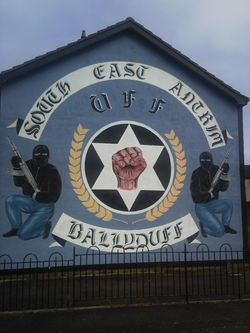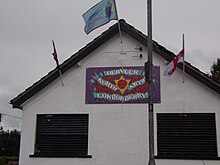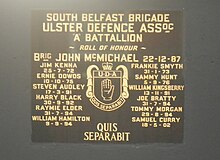Ulster Defence Association
The vast majority of its victims were Irish Catholic civilians,[12][13][14] killed at random, in what the group called retaliation for IRA actions or attacks on Protestants.[26]: 50 The structure of this new movement soon took shape with a thirteen-man Security Council established in January 1972 as a reaction to a Provisional IRA bomb the previous month at the Balmoral furniture showroom on the Shankill which killed four people including two infants.[25]: 22 By this point, Charles Harding Smith had become the group's leader, with former Royal Army Ordnance Corps soldier Davy Fogel as his second-in-command, who trained the new recruits in military tactics, the use of guns, and unarmed combat.In April 1972, the organisation's leader, Charles Harding Smith and leading UDA member John White were arrested in London for gun-trafficking.[25]: 34 Fogel was promptly ousted from the B Company command, while the formidable East Belfast brigadier, Tommy Herron, appeared on the scene to challenge Harding Smith's leadership.[30]: 114 The struggle that ensued between Harding Smith and Herron overshadowed the Inner Council and during the height of the feud Anderson often had to call a register at its meetings, so poor were the turnouts.[30]: 114 He publicly announced his resignation as joint chairman in March 1973, in part because he was a fairly law-abiding individual who sat uneasily with violently chaotic figures like Harding Smith and Herron.[25]: 64 As a compromise candidate between the rival factions of Harding Smith and Herron, Andy Tyrie, commander of West Belfast Brigade's A Company, was chosen as the UDA's chairman.Craig issued a warning during a rally at Ormeau Park the next month, where thousands of UDA men were present: "If the politicians fail us, it might become our responsibility to eliminate the enemy."[34][35] During this period of legality, the UDA committed a large number of attacks using the name Ulster Freedom Fighters,[36][37] including the murder of Social Democratic and Labour Party (SDLP) politician Paddy Wilson and his companion Irene Andrews in 1973.[42][43] Although they occasionally helped staff roadblocks, the women's units were typically involved in local community work and responsible for the assembly and delivery of food parcels to UDA prisoners.[47] Wendy Millar's Shankill Road group was a particularly active women's unit, and another was based in Sandy Row, south Belfast, a traditional UDA stronghold.[49] The Sandy Row women's UDA unit was disbanded after it carried out a vicious "romper room" punishment beating on 24 July 1974 which left 32-year-old Ann Ogilby dead.[50] The day of the fatal beating Ogilby was abducted and forced upstairs to the first floor of a disused bakery in Sandy Row that had been converted into a UDA club.[43] Starting in 1972 the UDA along with the other main Loyalist paramilitary group the Ulster Volunteer Force, undertook an armed campaign against the Catholic population of Northern Ireland that would last until the end of the troubles."[55] Active throughout the Troubles, its armed campaign gained prominence in the early 1990s through Johnny Adair's ruthless leadership of the Lower Shankill 2nd Battalion, C. Company, which resulted in a greater degree of tactical independence for individual brigades.Since the ceasefire, the UDA has been accused of taking vigilante action against alleged rival drug dealers,[64] including tarring and feathering a man on the Taughmonagh estate in south Belfast.The UDA has also been riddled by its own internecine warfare, with self-styled "brigadiers" and former figures of power and influence, such as Johnny Adair and Jim Gray (themselves bitter rivals), falling rapidly in and out of favour with the rest of the leadership.[68] Following an August 2005 Sunday World article that poked fun at the gambling losses of one of its leaders, the UDA banned the sale of the newspaper from shops in areas it controls.[73] In February 2006, the Independent Monitoring Commission (IMC) reported UDA involvement in organised crime, drug trafficking, counterfeiting, extortion, money laundering and robbery.[74] The move did see the southeast Antrim brigade of the UDA, which had been at loggerheads with the leadership for some time, support Shoukri and break away under former UPRG spokesman Tommy Kirkham.[55] However, the killing of McMichael that same year and the subsequent removal of Tyrie from the leadership and his replacement with an Inner Council saw the UDA concentrate on stockpiling weapons rather than political ideas.In early January 1994, the UDA released a document calling for ethnic cleansing and repartition, with the goal of making a new Northern Ireland which would have been wholly Protestant.Areas in the south and west with strong Catholic/nationalist majorities would be handed over to the Republic, and those Catholics left stranded in the "Protestant state" would be "expelled, nullified, or interned".[1] The term was coined in 1997 when members of the LVF carried out attacks on behalf of Johnny Adair's "UFF 2nd Battalion, 'C' Company (Shankill Road)" and vice versa.[1] There has been debate as to whether or not the Red Hand Defenders have become an entity in their own right[97] made up of dissident factions from both the UDA and the LVF (both of which have now declared ceasefires whilst the RHD has not), although much intelligence has been based on the claims of responsibility which, as has been suggested,[1] are frequently misleading."[99] An Irish government memo written by David Donoghue stated: "The commonest contribution of Scots UDA and UVF is to send gelignite.Explosives for the north were mostly shipped in small boats which set out at night from the Scottish coast and made contact at sea with vessels from Ulster ports."[100] The Northern Ireland Affairs Select Committee noted in its report that "in 1992 it was estimated that Scottish support for the UDA and UVF might amount to £100,000 a year.[102] On 10 February 1976, following the sudden uptick of violence against Catholic civilians by loyalist militants, Irish cardinal William Conway and nine other Catholic bishops met with British Prime Minister Harold Wilson and his cabinet, asking them as to where the loyalist militants had acquired guns, to which Secretary of State for Northern Ireland Merlyn Rees replied "Canada".









C KkompanyCharles Harding SmithAndy TyrieJohn McMichaelJackie McDonaldJohnny AdairJim GrayAndre ShoukriJames SimpsonBilly McFarlandUlster Young MilitantsBelfastNorthern IrelandRepublic of IrelandEnglandIdeologyUlster loyalismProtestant extremismIrish unionismAnti-CatholicismAnti-Irish sentimentUlster nationalismLoyalist Volunteer ForceRed Hand DefendersUnited KingdomBritish ArmyRoyal Ulster ConstabularyGarda SíochánaProvisional Irish Republican ArmyIrish National Liberation ArmyIrish People's Liberation OrganizationIrish republicansIrish nationalistsUlster Volunteer ForceThe TroublesDesignated as a terrorist groupUnited StatesUlster loyalistparamilitaryundertook an armed campaignUlster ProtestantIrish republicanismcover nameproscribedterrorist groupIrish CatholicTop of the Hill bar shootingMilltown massacreSean Graham'sJames Murray's bookmakers' shootingsCastlerock killingskillings of Paddy Wilson and Irene AndrewsGreysteel massacreceasefireTerrorism Act 2000loyalistvigilanteShankillWoodvale Defence AssociationsBilly HullProvisional IRABalmoral furniture showroomRoyal Army Ordnance CorpsDavy FogelTommy HerronbattalionscompaniesplatoonssectionsJohn Whiteno-go areaRobert FordQuis separabitVanguardWilliam Craig1977 loyalist strikePeter Robinsonthat year's general electionSocial Democratic and Labour PartyPaddy WilsonUlster Workers Council StrikeSunningdale Agreementunionistsnationalistgeneral strikeGlenn BarrThe WomblesparkasNewtownards RoadShankill RoadWendy "Bucket" MillarLoyalist Association of WorkersHester DunnSandy RowAnn OgilbyMaze Prisonthe children's television programmeTimeline of Ulster Defence Association actionsRed Hand of UlsterStephen McKeagUlster ResistanceDemocratic Unionist PartyLebanonKilcooley estateBangorDavy PayneBrian NelsonStevens Inquiry TeamForce Research UnitIntelligence CorpsGreysteelCounty LondonderryHalloweenShankill Road bombingUniversity of UlsterCAIN projectStevens Enquirymodus operandiPaul MurphyChief ConstablePolice Service of Northern IrelandHugh Ordetarring and featheringJohn GreggFrankie GallagherSunday World